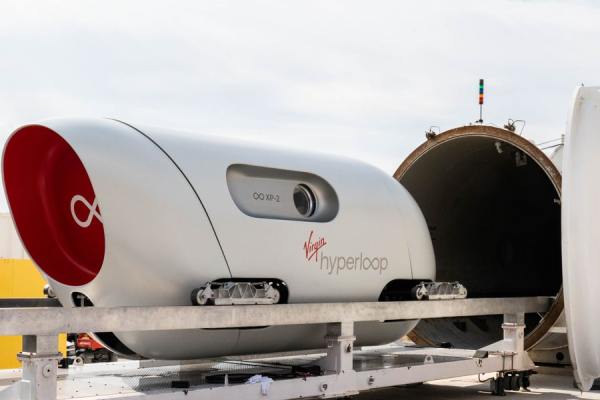Published on the 17/11/2020 | Written by Heather Wright

Musk’s pipedream does the ton, with passengers on board…
Elon Musk’s infamous Hyperloop vacuum train has re-emerged with the high speed transportation taking its first two passengers for a ride.
The futuristic system, which uses magnetic levitation to lift passenger capsules above a track and push them forward through a vacuum tube for near frictionless travel, was much touted several years ago – including the spruiking of plans for Australia, with promises of travel between Melbourne and Sydney in just 50 minutes for the 880km journey.
“It’s a giant leap toward that ultimate dream.”
Promises of transporting people and goods at speeds of up to 760 miles an hour (1,223km/hour) saw the system garner plenty of media coverage, before fading from the limelight somewhat. Tests continued, and a range of other companies joined the fray, but hyperloop’s allure briefly faded. Promises of the first working hyperloop systems being running by 2020 came to nought. Even the appearance of Richard Branson’s Virgin Group joining the party in 2017, with a strategic investment partnership which saw Musk’s Hyperloop One become Virgin Hyperloop, failed to reignite the hype.
Last week’s test trip, however, has reignited interest again.
The test trip, which lasted all of 15 seconds, saw Virgin Hyperloop’s co-founder, Josh Giegel and the company’s director of passenger experience, Sara Luchian, travelling less than 500 metres through an airless tunnel at 107 miles per hour on the test track in the Nevada desert in the two-seater floating pod. (To put that into perspective, the Shanghai Maglev (magnetic levitation) train, which started service back in 2004, travels at 267 miles per hour and Japan’s famed Shinkansen runs at 224mph, while the Eurostar reaches speeds of 200mph. Maglev trains have been hitting speeds in excess of 300 miles per hour since the late 1970s – and carry hundreds of passengers, rather than just two.)
Giegel, however, dubs the test ‘a giant leap toward that ultimate dream, not only for me, but for all of us who are looking towards a moonshot right here on earth’.
Hyperloop’s production vehicles will be larger, seating up to 28 passengers.
Jay Walder, Virgin Hyperloop CEO, says the passenger testing demonstrates Virgin Hyperloop safely put a person in a pod in a vacuum environment.
Plenty of safety questions remain however, with any issue with the vacuum tube or the pod potentially fatal should the system reach its touted 760mph speeds.
In July 2020, the US Department of Transportation and the Non-Traditional and Emerging Transportation Technology Council debuted a guidance document setting out the regulatory framework for hyperloop in the United States. The guidance, and classification of hyperloop, makes it eligible for government infrastructure funds.
For all the – slow – forward movement, many remain sceptical about a future of hyperloop travel, noting the exorbitant costs (the planned Abu Dhabi-Dubai hyperloop system comes with a price tag of around $40 million per kilometre, Musk’s own estimates have suggested an LA-San Francisco offering would cost more than $7 billion, a figure many suggest is conservative). Questions remain too, on where the economic return, or any savings over planes, will come from – at least for passengers. Freight, on the other hand, may make more sense, some economists and transport experts say.
Maintaining a vacuum in the tube also remains a challenge, especially in longer tubes, which, given the hyperloop premise, will likely be most.
Despite the reservations, however, there are plenty pursuing the hyperloop dream. Virgin Hyperloop competitor, HyperloopTT, which has an R&D centre in Toulouse, France, has signed an agreement in China to build a test track, and just days after Virgin Hyperloop’s manned trial, the Korean Railroad Research Institute (Korail) was proclaiming that its ‘hyper-tube train’ – or at least a scale model of it – had hit speeds of 633mph (1,019km/h).



























